This article includes a list of general references, but it lacks sufficient corresponding inline citations .(March 2019) |

Craigend Castle is a ruined country house, located to the north of Milngavie, in Stirlingshire, central Scotland.
This article includes a list of general references, but it lacks sufficient corresponding inline citations .(March 2019) |

Craigend Castle is a ruined country house, located to the north of Milngavie, in Stirlingshire, central Scotland.
The lands of Craigend were part of the Barony of Mugdock in medieval times, but the estate was sold in the mid-17th century to the Smith family. John Smith (1724–1812) was born at Craigend and became a merchant and the founder, in 1751, of booksellers John Smith & Son. John Smith built a plain house on the estate, but after his death, in 1816, his son, James Smith, incorporated that house in a much more ornate mansion. It was built by Alexander Ramsay, initially using designs by James Smith of Jordanhill, in what is described as Regency Gothic style. [1]
Craigend was sold to Sir Andrew Buchanan, the former Ambassador to the Habsburg court in Vienna, in 1851.
James Outram, chartered accountant and nephew of George Outram the one-time owner of the Glasgow Herald newspaper, later leased the Castle from the Buchanan family in the early years of the 20th Century.
In 1920, Craigend Castle was tenanted by Sir Harold E. Yarrow, Chairman & Managing Director of Yarrow Shipbuilders, who moved there from 'Fairlawn', Ralston Road, Bearsden. Glasgow businessman Andrew Wilson and his zoologist son, William, bought part of Craigend Estate from the Buchanan family and opened a zoo at Craigend Castle and stables in 1949, with various exotic animals, but it failed to attract significant visitors and eventually closed in 1955.
The stables and zoo grounds became part of Mugdock Country Park but the main house has become a ruin. The stable block, located to the north of the house, now serves as the country park visitor centre. Craigend Estate, adjacent, is privately owned and is operated as a cattle and sheep farm.

Wimpole Estate is a large estate containing Wimpole Hall, a country house located within the Parish of Wimpole, Cambridgeshire, England, about 8+1⁄2 miles southwest of Cambridge. The house, begun in 1640, and its 3,000 acres (12 km2) of parkland and farmland are owned by the National Trust. The estate is regularly open to the public and received over 335,000 visitors in 2019. Wimpole is the largest house in Cambridgeshire.
Sir Hugh Fraser, 2nd Baronet, formerly 2nd Baron Fraser of Allander, was chairman of the House of Fraser, Harrods, George Outram and Company, and Whyte and Mackay. He lived at Mugdock, near Milngavie, Scotland. He was the son of Hugh Fraser, 1st Baron Fraser of Allander, and inherited the Barony of Fraser of Allander on his father's death in 1966, but disclaimed it for life the same year. He has three daughters: Patricia, Belinda and Caroline. He was not related to the politician Sir Hugh Fraser.

Mugdock Country Park is a country park and historical site located partly in East Dunbartonshire and partly in Stirling, in the former county of Stirlingshire, Scotland. It is around 10 miles north of Glasgow, next to Milngavie, and covers an area of 260 hectares.
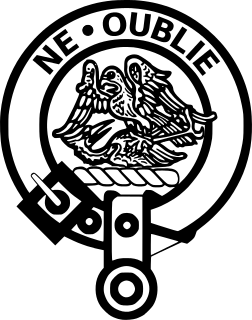
Clan Graham is a Scottish clan who had territories in both the Scottish Highlands and Lowlands.
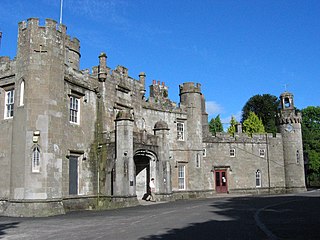
Balloch Castle is an early 19th-century country house situated at the southern tip of Loch Lomond, in West Dunbartonshire, Scotland. Balloch was a property of the Lennox family from the 11th century, and the old castle was built in the 13th century. In the 19th century the estate was purchased by John Buchanan of Ardoch, who demolished the ruins of the old castle and erected the present building. The Tudor Gothic architecture is the work of Robert Lugar. In 1915 Balloch was bought by Glasgow City Corporation, and has been leased by West Dunbartonshire Council since 1975. The estate was designated as a country park in 1980, and since 2002 has been part of Loch Lomond and The Trossachs National Park. Although the house has been periodically used for visitor facilities and council offices, it is now included on the Buildings at Risk Register. Balloch Castle is a category A listed building, and the estate is included on the Inventory of Gardens and Designed Landscapes in Scotland.

Strathblane is a village and parish in the registration county of Stirlingshire, situated in the southwestern part of the Stirling council area, in central Scotland. It lies at the foothills of the Campsie Fells and the Kilpatrick Hills on the Blane Water, 12 miles (19 km) north of Glasgow, 14 miles (23 km) east-southeast of Dumbarton, and 20 miles (32 km) southwest of Stirling. Strathblane is a dormitory village for Greater Glasgow, and has a total resident population of 1,811.

Clan Buchanan is a Highlands Scottish Clan whose origins are said to lie in the 1225 grant of lands on the eastern shore of Loch Lomond to clergyman Sir Absalon of Buchanan by the Earl of Lennox.

Buchanan Castle is a ruined country house in Stirlingshire, Scotland, located 1 mile (1.6 km) west of the village of Drymen. The house was commissioned by The 4th Duke of Montrose and built in 1852-1858 as a home for the Montrose family, serving as such until 1925. It was built as a replacement for Buchanan Auld House, which is located 0.5 miles (0.80 km) to the northwest but was destroyed in a fire in 1852. The old house and surrounding lands had been the property of the Clan Buchanan but passed to the Clan Graham in the late 17th century. The roof of the building was removed in 1954 and the condition of the house has since deteriorated, but it remains the seat of the Clan Graham.
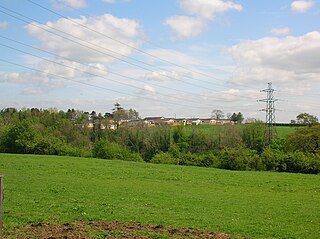
The Cunninghamhead Estate is in the 21st century mainly a residential caravan park with two private residences near Irvine, Scotland. It was once a private estate, owned by a sequence of recorded families since around 1418. The Mansion House, one of Britain's lost houses, was built in 1747; it was destroyed by fire in the early 1960s, whilst renovation work was being carried out. The old mansion and castle have been lost, however the stables are still a residence, whilst the Gardner's Cottage survive as ruins. From 1964, work was carried out, first to use the estate as a chicken farm and later as holiday and residential, caravan park and camping site, making most of the rural location. Circa 2003 the site was significantly redeveloped to become a residential caravan park exclusively for the use of retired and semi-retired persons.
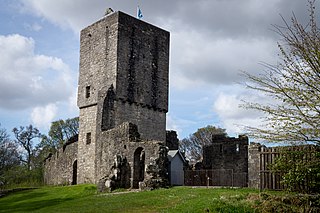
Mugdock Castle was the stronghold of the Clan Graham from the middle of the 13th century. Its ruins are located in Mugdock Country Park, just west of the village of Mugdock in the parish of Strathblane. The castle is within the registration county of Stirlingshire, although it is only 2 kilometres (1.2 mi) north of Milngavie, East Dunbartonshire, on the northern outskirts of Greater Glasgow.

Montgreenan is an estate in North Ayrshire, Parish of Kilwinning, Scotland. The Lugton Water runs through the policies and farmland of Montgreenan. Nearby are the hamlets of Torranyard and Auchentiber.

Alexander Ramsay was a Scottish builder and architect.

Mugdock is a hamlet in Stirlingshire, Scotland. It lies to the south of the village of Strathblane, and was in the civil parish.

The Castle and Barony of Robertland is located near Stewarton, off the B769 road, in the old district of Cunninghame, Parish of Stewarton, and now part of East Ayrshire, Scotland.

Polkemmet Country Park is located 2 kilometres (1.2 mi) west of the town of Whitburn in West Lothian, Scotland and east of the village of Greenrigg. It is a 3 star Visitor Attraction (Visitscotland). It is adjacent to the M8 motorway, 2 kilometres (1.2 mi) east of the "Heart of Scotland" services at Harthill. It was developed on the estate of Polkemmet House, a country house which was demolished in the 1960s. The estate was bought by West Lothian District Council in 1978, and the country park was opened to the public in 1981. The park covers 169 hectares, and is managed by West Lothian Council.

Finlaystone House is a mansion and estate in the Inverclyde council area and historic county of Renfrewshire. It lies near the southern bank of the Firth of Clyde, beside the village of Langbank, in the west central Lowlands of Scotland.
Touch House is a country house located 4 kilometres (2.5 mi) west of Stirling in central Scotland. It stands at the foot of the Touch Hills, on the south side of the River Forth. The house incorporates a 16th-century tower house, but its present form dates to the middle of the 18th century when the south facade was added, described by Historic Environment Scotland as "Probably the finest Georgian elevation in the County of Stirling."
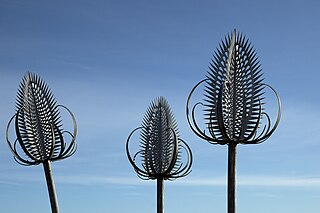
Muiravonside Country Park is 170 acres of woodland and parkland open to the public all year round with marked trails, picnic sites and a play area. It is situated in the south-east corner of Falkirk, approximately 1 mile (1.6 km) south of Maddiston, 2 miles (3.2 km) south-east of Linlithgow and about 4 miles (6.4 km) north of Armadale and Bathgate. It was once the grounds of Muiravonside House and the country estate owned by the Stirling family of Falkirk.
Clan Edmonstone is a Scottish clan which does not currently have a chief; therefore, it is considered an armigerous clan. However, Sir Archibald Bruce Charles Edmonstone, 17th of Duntreath is considered the Chieftain for the Edmonstones of Duntreath. It has been speculated that much, if not all, of the senior line of the Edmonstone Clan has died off. Most Edmonstones are believed to be descended from the Edmonstones of Duntreath.

Rosshall is an area in the south-west of Glasgow, Scotland, within the Cardonald ward of Glasgow City Council. It has a fairly isolated location, with the White Cart Water forming a border to the south and east, the Paisley Canal Line railway to the north, and open fields to the west that form a short green belt between Glasgow and the large town of Paisley – the nearest building 500 yards (460 m) to the west, Rosshall Mains Farm, falls under Paisley administration rather than Glasgow.